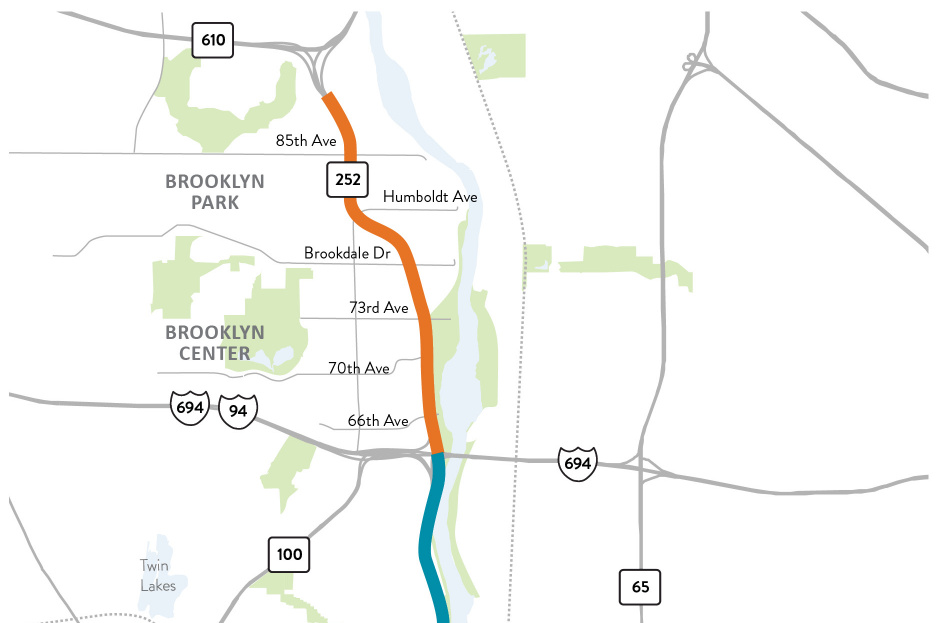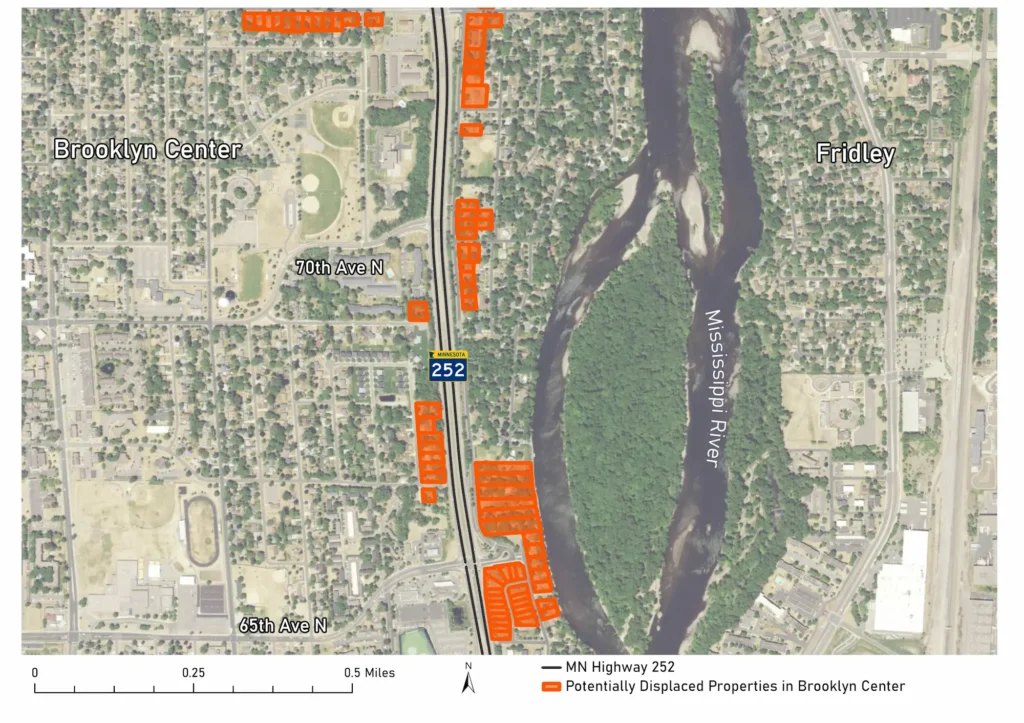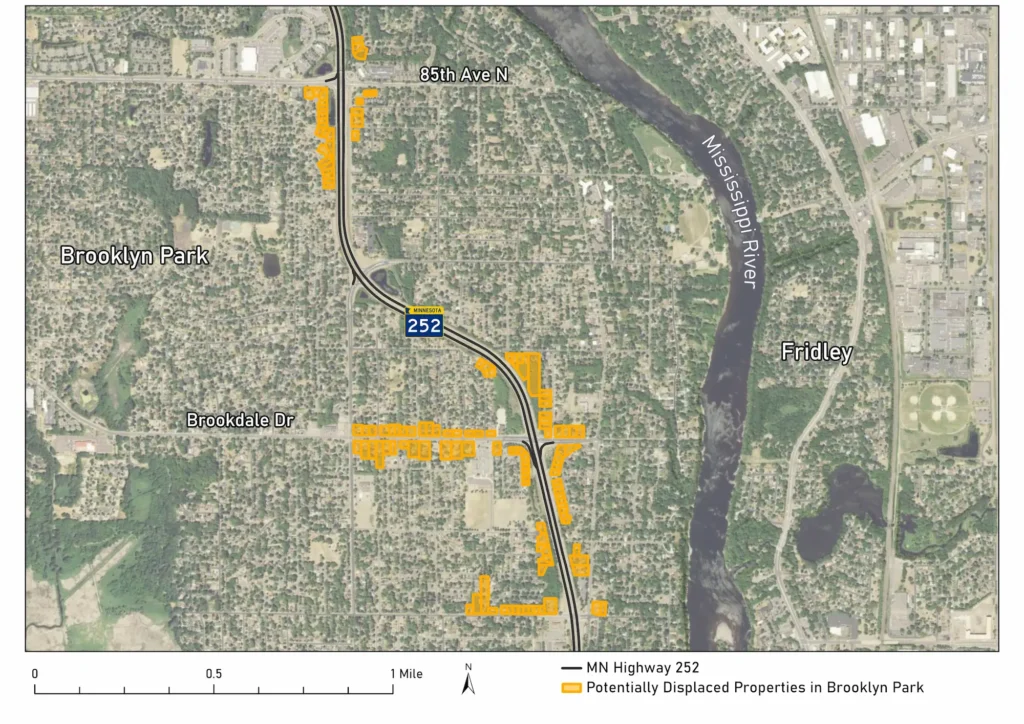
Highway 252, originally a local arterial road in Brooklyn Park and Brooklyn Center, was expanded to an expressway in the late 1980s to accommodate suburban growth and commuter traffic. This expansion and the earlier construction of I-94 disrupted community connectivity and subjected residents to poor air quality, noise pollution, and displacement. These roadways severed residential neighborhoods from the Mississippi River and surrounding areas, fragmenting local communities and limiting access to urban amenities.
According to the Minnesota Department of Transportation (MnDOT), the Highway 252/I-94 corridor is a major Twin Cities artery, connecting northern suburbs to Minneapolis employment centers and other key highways. About 47% of Highway 252 traffic consists of regional through trips, with daily volumes ranging from 57,000 to 66,000 vehicles on Highway 252 and 89,000 to 111,000 on I-94. The corridor serves significant commuter traffic, reflected in directional peak flows (southbound mornings, northbound afternoons).
Public transit shows strong ridership along the corridor, indicating that more transit investments are needed along 252 to serve Brooklyn Park and Brooklyn Center residents. Six Metro Transit express routes on Highway 252 serve 4,800 daily riders, while I-94 south of Highway 252 handles 20 bus routes carrying 12,650 daily riders, making it one of the Twin Cities’ busiest express bus corridors.
Despite strong transit ridership, MnDOT is advancing major changes to Highway 252 between the I-94/I-694 junction and Highway 610 that put cars over people. Their main proposal is to convert this stretch into a grade-separated freeway with large interchanges. Specific design options vary from four to six lanes. MnDOT is also exploring alternatives such as adding MnPass lanes on I-94 to increase capacity or simply maintaining the current road with necessary repairs.
This project was created to increase traffic capacity between the Northwest exurbs and downtown Minneapolis. It was originally funded through the Corridors of Commerce program, a fund specifically created to widen highways that serve as major freight corridors. Recently as public opposition has grown, MnDOT has shifted its messaging and is selling the project as a way to “improve safety”. While there is no denying that Highway 252 in its current form is unsafe, converting the highway into a wider freeway with more traffic and faster speeds will only make crashes more severe. Citing safety issues is a classic tactic used across the country to justify highway expansion.
If MnDOT moves forward with highway expansion, approximately 210 homes and businesses may be destroyed in Brooklyn Park and Brooklyn Center, two of the Twin Cities’ most racially diverse suburban communities, in the largest highway-driven land acquisition in a generation.
74 Potentially Displaced Properties in Brooklyn Center

135 Potentially Displaced Properties in Brooklyn Park

This project repeats a harmful history of the State of Minnesota ramming highway expansion projects through communities of color.
Like previous highway projects, the proposed expansion threatens to displace adjacent residents, seize property, and disrupt community bonds. Those who remain will suffer increased traffic– expected to be double current levels– as well as tire pollution, and vehicle tailpipe pollution. Census tracts show that 52.3% of impacted residents are people of color, significantly higher than the regional average of 31%.
Community members and elected officials have been rallying against the project, highlighting its ongoing gaps.
“When we found that there was a plan to turn Highway 252 through Brooklyn Center and Brooklyn Park into a freeway, we became very concerned,” said local resident Nahid Khan. “The increase in traffic, air pollution and the impact it would have on all the surrounding neighborhoods, including ours, and the destruction of neighborhoods through the seizures of numerous properties of affordable housing, local businesses, and other community institutions” gave rise to such concerns, said Kahn.
These impacts extend more broadly, too.
On the regional level, expanding Highway 252 is likely to increase traffic due to induced demand, a widely accepted transportation reality where new roads generate more traffic. This phenomenon often leads to worsened congestion, contradicting the project’s goals.
At the state level, Minnesota has a lot to gain from moving away from highway expansions and embracing climate-smart transportation. One estimate found that we could reap financial benefits of over $90 billion if we prioritize transit and other non-car-oriented investments including improved health, safety, and reduced costs for Minnesotans at the pump and the mechanic.
Upcoming Meetings
Virtual Policy Advisory Committee Meeting
Monday, October 28, 1-3PM
Register for the meeting (via Zoom)
Virtual Public Meeting
Wednesday, November 13
Register for the meeting (via Zoom)
Who’s involved?
Corridor Cities
Corridor cities include the City of Brooklyn Park, City of Brooklyn Center and City of Minneapolis. The project team works with the corridor cities to determine if municipal consent is needed per state statute.
Project Management Team
The Project Management Team (PMT) includes MnDOT’s Highway 252 / I-94 Project Manager, West Area Manager and West Area Engineer, FHWA, in addition to the Project Consultant’s Project Manager, Environmental Manager, Public Engagement Manager and Communications Assistant.
Technical Advisory Committee
The Technical Advisory Committee (TAC) includes staff from Hennepin County, City of Brooklyn Park, City of Brooklyn Center, City of Minneapolis, MnDOT, FHWA, Metropolitan Council, Metro Transit and Project Engagement Team. The TAC meets approximately monthly.
Policy Advisory Committee
The Policy Advisory Committee (PAC) includes elected and appointed officials from MnDOT, the State of Minnesota, FHWA, Hennepin County, City of Brooklyn Park, City of Brooklyn Center, City of Minneapolis and Metropolitan Council. The PAC Chairs include the MnDOT Commissioner and City of Brooklyn Center mayor. The PAC meets approximately quarterly and meetings are open to the public. The PAC is not a decision-making body.